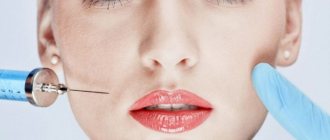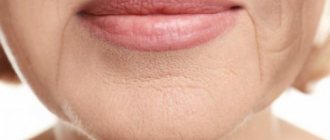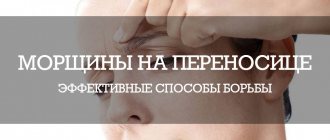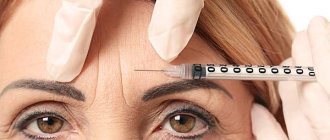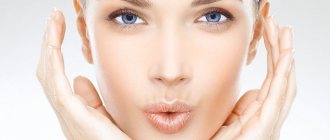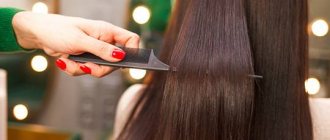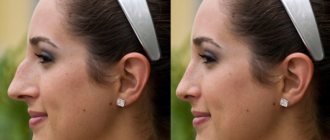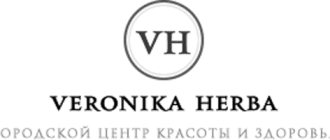Wrinkles under the eyes may appear earlier than in other areas, because the skin here is thin, devoid of fat, and constantly forced to withstand significant loads. At risk for the appearance of deep wrinkles around the eyes are women and men with very active facial expressions and those who like to squint constantly. Fine wrinkles under the eyes can appear as early as 20-25 years old; over time they only become deeper and more noticeable. Stress, bad habits, and negative heredity accelerate the manifestation of age-related changes. You have two options - either leave everything as it is, or start fighting with age. Read more about the methods used at GMTClinic.
DRUGS AND DEVICES USED IN THE CENTER FOR THE PROCEDURE
The following methods can effectively and quickly remove wrinkles under the eyes:
- Anti-wrinkle eye mesotherapy eliminates even very deep furrows and is carried out by injection using cocktails. A needle or cannula is used to administer drugs.
- Dermadrop is a non-injection mesotherapy.
- Biorevitalization is aimed at filling folds with hyaluronic acid.
- Botulinum therapy (BTA) – botulinum blocks nerve impulses, resulting in the disappearance of expression wrinkles in the eyes.
Other methods of rejuvenation are fractional resurfacing, laser peeling, TCA chemical peeling. You can use these methods independently or in combination to improve results.
Wrinkles are different from wrinkles: what types of wrinkles are there?
The first wrinkles can appear very early, first on the forehead or in the corners of the eyes. This is not yet withering of the skin, but simply a consequence of the activity of facial muscles - the habit of wrinkling the forehead or squinting the eyes.
With age, the soft tissues of the face, due to various reasons, including the effect of gravity (from the Latin gravitas - heaviness), sag, become sour, and subcutaneous fat tissue is redistributed. At the same time, the contour of the face and neck is disrupted, eyebrows and eyelids begin to droop, the corners of the mouth droop and folds form. It is these complex changes that are an indication for contacting cosmetic surgeons. Cosmetic surgery today offers many ways to combat wrinkles, let's get acquainted with some of them.
PREPARATION FOR THE PROCEDURE, REHABILITATION, CONTRAINDICATIONS
To remove wrinkles under the eyes after 40 years or at an earlier age (from 25-30 years), you do not need to give up your usual lifestyle, but you need to make some adjustments to improve the results of the procedure and minimize possible side effects. 2 weeks before and a month after the procedure, you need to stop visiting solariums, beaches, and increased physical activity; stop taking blood thinning medications a week or at least 3-4 days. After rejuvenation, you should not sunbathe, visit baths, saunas, or use decorative cosmetics. Contraindications – acute and chronic diseases, pathological changes in the epidermis in the area, cancer, other serious pathologies, lactation and pregnancy. There are also relative contraindications - they are rather precautionary measures.
What causes wrinkles under the eyes
In the adult human body there are about 400 muscles, the contraction of which is controlled by the central nervous system. Moreover, 57 of them are located under the skin of the face. Facial muscles, contracting for their natural reasons, form folds - facial wrinkles. They appear by the age of eighteen to nineteen, and if you do not pay attention to this problem in time, then over time a characteristic network appears around the eyes, which is often called “crow’s feet.” It is in these places that the skin is especially delicate. There are very few sebaceous glands that provide natural normal hydration, and the facial muscles have to work even in sleep. Every year, the skin loses moisture and elasticity, becomes less elastic, wrinkles do not smooth out for a long time and eventually “settle” on the face thoroughly.
The reason for the formation of wrinkles lies in collagen, a protein responsible in the body for the elasticity and strength of the dermis. As you age, your body gradually reduces collagen production. Collagen is the main component of connective tissue and the most abundant protein in our body. If there is little collagen, then the skin looks dull, flabby, and wrinkles are pronounced on it. Therefore, you need to properly care for your facial skin from your youth, since in adulthood, removing deep wrinkles under the eyes will become a troublesome and expensive task.
Incorrect or poor nutrition can be put on par with an age-related decrease in collagen in the body. Not only the condition of our internal organs, but also our appearance and even our mood depends on what we eat.
External factors can also negatively affect the production of collagen proteins:
ŸFine wrinkles like to appear under the influence of excessive sunlight, cold weather and wind. Frost, wind and sun equally negatively affect the condition of the skin. Those who like to frequently visit the solarium also need to be on alert. As well as natural factors, ultraviolet light mercilessly dries the skin. It removes moisture from its surface and thereby contributes to the appearance of wrinkles.
ŸIn early youth, deep wrinkles may appear due to frequent drinking and smoking. Often, one glance is enough for an experienced specialist to recognize the presence of bad habits that adversely affect the condition of the skin.
ŸIncreased emotionality. The habit of frowning eyebrows, violent expression of emotions through facial expressions are usually considered among the natural causes of the appearance of “crow’s feet.”
ŸImproper facial care, especially with alcohol-based cosmetics. Excessive use of such cosmetics often leads to irritation and flaking of the skin. In addition, the alcohol content in our usual “washes” and tonics increases the risk of allergic reactions. But its main danger lies in its ability to remove moisture. By cleansing the skin with alcohol-based products, we at the same time dry out the skin. Insufficient hydration is considered one of the main reasons leading to the appearance of wrinkles.
It is generally accepted that oily skin is less susceptible to wrinkles. This controversial judgment is only partly true. In people with this type of skin, age-related wrinkles actually appear a little later than in people with dry skin, but due to the increased activity of the sebaceous glands, wrinkles are usually more pronounced. And with oily skin types, and with very dry and combination skin types, the skin under the eyes remains the thinnest and most sensitive. If we add the genetic factor to everything else, we get the same result - wrinkles. Regardless of skin type and age, to prevent the appearance of wrinkles around the eyes and not spend money on an expensive remedy for wrinkles under the eyes, just follow simple recommendations.
"Golden Threads"
“golden threads” began to be used to correct wrinkles and other age-related skin changes .
The result of this operation is called reinforcement
, is a rejuvenating effect. It is expressed by the elasticity and firmness of the skin and, therefore, by reducing the depth or eliminating wrinkles.
Using a special needle, the doctor inserts a thin gold thread with a diameter of 0.1 mm under the skin of the face and neck, which is “accompanied” by a polyglycol thread. This absorbable polymer base is necessary in order to correctly position the gold thread. The body responds to the insertion of the thread by forming new rows of collagen fibers around it, creating a “framework” that supports the muscles for many years. The use of gold is dictated by the fact that it does not cause allergies, does not oxidize, and does not cause a rejection reaction in the body.
With maximum effect, this manipulation lasts up to 40 years. However, the best age for her is 30-38 years, when the first signs of aging appear, but the reserve capacity of the skin is still high, and therefore the synthesis of collagen and elastin is at a fairly high level.
The procedure for introducing gold threads lasts about 30-40 minutes under local or general anesthesia. After inserting the threads into the willow, the puncture site is fixed with a plaster for about a day. After the operation, the patient can go home the same day. During the recovery period, as well as any surgical intervention, soft tissue swelling develops and hemorrhages appear, which disappear after 7-10 days. There are usually no other side effects. The first results are visible no earlier than 1.5-2 months: the complexion improves, wrinkles begin to smooth out, the skin becomes more elastic. After 6 months, you can evaluate the obvious results of rejuvenation. It should be noted that the rejuvenation effect increases over 2 years and can last 8 - 12 years, depending on the characteristics of the body, age, and the initial condition of the skin. For some, the cosmetic effect of the operation is very pronounced and lasts a long time. Others need to combine reinforcement with other types of plastic surgery, gel, braces, etc.
Lifting
The word “lifting” comes from the English to lift - to raise or tighten. That is, lifting is the same skin tightening
, which you can read about in advertising or hear from friends. Lifting is the elimination of wrinkles and folds as a result of skin tension and removal of excess skin.
There are various lifting options. Their choice depends on the changes that the patient has, her requirements and expectations, and the surgeon’s opinion. When performing these operations, the surgeon makes skin incisions - in the scalp, and natural folds of the skin, in front and behind the auricle, that is, where they will be least noticeable.
A facelift can be complete or limited. Wrinkles and folds of the cheeks, temples and neck are completely eliminated. For limited lifting, “excess” skin is removed from the temporal or cheek areas.
It is also possible to tighten deeper tissues - the superficial muscular aponeurotic system of the face (or abbreviated SMAS, in English it sounds like superficial mascula aponeurotic sustem), which can significantly improve the contour of the face.
A facelift may be accompanied by correction of subcutaneous fat; liposuction, that is, removal of fat, often in the chin area; and, conversely, lipofoling - the introduction of fat grafts to areas where they are lacking.
In recent years, endoscopic lifting methods have become increasingly popular, in which the operation is performed through small incisions in the skin using special fiber optics. Optical magnification allows you to see the surgical area in more detail and allows for precise muscle dissection to eliminate forehead wrinkles and lift eyebrows. Endoscopic surgery is characterized by less trauma and, therefore, a shorter recovery period. This type of operation is especially indicated for women with thin, sparse hair who will not be able to hide a scar, albeit small.
Lifts are often performed under general anesthesia. Any aesthetic operation is accompanied by a postoperative period and requires a certain patience from the patient. The severity of swelling and bruising depends on the individual characteristics and complexity of the operation. Physiotherapeutic procedures, massage and drug treatment can shorten the postoperative period.
Lifting not only eliminates signs of aging, but also prevents their occurrence. The result obtained lasts for 7-10 years, and sometimes longer. Carrying out maintenance procedures with cosmetologists-dermatologists and good cosmetic care will certainly prolong the result.
Lifting is often performed on women after 40-50 years of age, sometimes earlier, when patients are highly demanding of their appearance.
How is eyelid plastic surgery performed?
Successful correction of such sensitive areas on the face requires high professionalism and extensive practical experience. SM-Plastik specialists are fully qualified. When planning a blepharoplasty operation, the clinic’s surgeons determine the most suitable type:
- A circular lift is a universal method that allows you to comprehensively correct most cosmetic problems in the periocular area.
- Upper eyelid lift – eliminates sagging and removes fat deposits in this area.
- Correction of the lower eyelids is the main method of getting rid of bags under the eyes. Here, in some cases, it is even possible to perform eye blepharoplasty without incisions, which significantly shortens the recovery period.
- Correction of the outer corners of the eyes - eliminates wrinkles in this area and forms an almond-shaped palpebral fissure.
- Asian palpebral fissure correction – gives the face Caucasian features by removing the epicanthus.
Our surgeons always try to make incisions in natural skin folds. Thanks to this, postoperative scars are almost invisible.
To undergo eyelid surgery, the patient needs to be hospitalized for 2-3 days. The operation is performed using general anesthesia and lasts on average about 2-3 hours.
Lipofilling
Method of surgical correction of cosmetic defects using the injection of fat cells
patients call lipofilling. It allows you to shape the contour of the face, fill folds in the bridge of the nose, corners of the mouth and under the eyes, smooth out wrinkles between the eyebrows, and correct retracted scars. In addition, this is one of the most optimal methods for correcting post-traumatic skin defects.
First, in the area of excess fat, usually on the thighs, a skin puncture is made and the fatty substrate is sucked out with a thin tube connected to a syringe. Then it is injected into the area to be corrected.
The procedure is performed under local anesthesia. It should be taken into account that after 6 months the volume of adipose tissue will partially decrease, so if necessary, the procedure can be repeated.
After the procedure, swelling may be observed, the peak of which occurs on the second or third day. By the sixth to eighth days the swelling completely disappears.
The result obtained is saved forever.
Lipofilling is contraindicated for those who suffer from diabetes mellitus and diseases associated with impaired blood supply. In such diseases, the transferred fat cells often die. Therefore, the desired result will not occur.
After surgery, the patient can go home the same day, although her social activities may be limited as the postoperative period is usually accompanied by swelling and bruising.
Advertising
